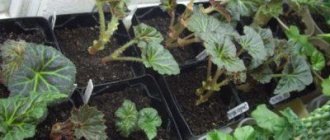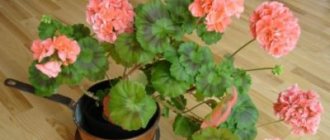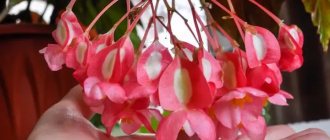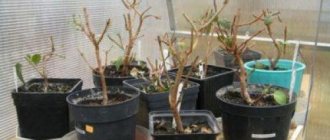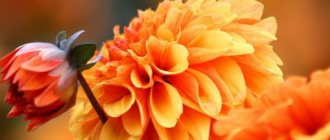Geranium, or pelargonium, is not only an indoor, but also a garden flower, forming an endless number of inflorescences in the summer and finishing blooming only when cold weather sets in. But most often, gardeners grow it as an annual, allowing the cold to destroy entire bushes with lush flowers. But pelargoniums can be grown as perennial plants, despite the fact that they do not overwinter in open ground, even with the construction of a reliable shelter.
Some gardeners practice storing geraniums at home in winter. Thanks to simple manipulations performed with garden flowers, you can provide yourself with planting material for the next year. Therefore, there is no need to purchase seeds and grow seedlings. And this saves money and time. Let's find out how to properly preserve pelargonium in an apartment in order to plant it in the garden next spring.
Periods of growth and dormancy of pelargonium
Pelargonium has pronounced periods of growth and dormancy. They especially stand out when grown as a houseplant. In summer, geranium blooms profusely, forming spherical lush inflorescences of predominantly red shades (the color of the flowers depends on the variety). Then, when cold weather sets in (in September), and the length of daylight hours begins to decrease significantly, flowering stops. At this time, geranium enters a period of rest, during which the metabolism slows down and energy is consumed economically. At the same time, it requires almost no nutrients and moisture.
In the spring, when the first rays of the sun begin to shine (in March), the flower wakes up. His metabolism accelerates and he begins to consume large amounts of minerals and water. All this leads to rapid flower growth and the formation of many long peduncles with gradually swelling buds. Pelargonium begins to bloom at home with proper care in April or May.
Description of the plant
Geranium belongs to the Geraniaceae genus.
Under natural conditions, the plant grows in South Africa. Now the genus has more than 250 species, and new varieties developed by breeders are added to them every year. Their flowering differs in many ways from the usual “ball”; the bushes form on their own and do not stretch out due to lack of light, but ordinary geraniums can also be pruned, ensuring the formation of a beautiful bush. Plants of this genus can be divided into two groups:
- blooming - valued for their lush flowering, which pleases the gardener almost all year round;
- fragrant - this plant also blooms, but in comparison with previous species it is imperceptible, valued for the aroma exuding from the leaves; they can smell of lemon, mint, spruce and even Coca-Cola.
The root system of the plant is branched. The stem is erect or creeping in some species. The leaves have the appearance of a dissected blade and are covered with small hairs. Flowers are presented in the form of an inflorescence - a brush; it can have more than 40 buds.
The plant blooms all year round provided the temperature conditions, day length and regular application of mineral fertilizers to the soil are provided. After the inflorescence ripens, a fruit-box is formed, which contains small seeds.
When to move geraniums from the garden indoors
The dormant period for geraniums begins in September. Therefore, it is at this time that you should move it home from the garden, even though it still has many flower stalks with lush and fresh inflorescences left. Do not spare them, because if you leave the plant in open ground, you risk exposing it to frost. Then one morning you will realize that there is nothing left to save for next year.
The beginning or middle of September is the best time for pelargonium to complete the period of active growth and flowering in central Russia and the Moscow region. At this time, the duration of daylight hours decreases to 8-9 hours, which is very little for a plant that loves bright sun.
In the Urals and Siberia, geraniums should be removed in August, since the first frosts often occur in the summer. But in the south of the country this can be postponed until October or even early November, provided that the temperature outside at night does not drop below +10 °C.
Methods for storing pelargoniums (geraniums) in winter
There are three methods for storing pelargonium in winter at home:
- in the apartment;
- in the basement in a pot;
- in the basement without a potty.
The first method is the easiest:
- Dig up the garden geranium and prepare a suitable size pot for it.
- Fill it with either universal soil or soil taken from the place where you dug up the flower. Don't forget about drainage at the bottom.
- Plant pelargonium and take it to your apartment.
- Place it in a bright window or other well-lit but cool place. Make sure that the leaves of the plant do not touch the window glass.
- If the sun hardly shines into your apartment, provide the plant with artificial lighting. You need to shine on it for 10-12 hours a day.
- Provide air temperature in the range of +10…+15 °C. The minimum permissible temperature for this content is +4 °C.
- Geranium does not particularly respond to air humidification, so dry winter apartment air will not harm it. However, dry air (less than 30-40%) should be avoided, otherwise the leaves will begin to dry out.
- Water the flower regularly. In winter, watering frequency is approximately once a week.
When storing pelargonium in the basement, it is important to comply with the following conditions:
- maintaining the temperature at +2…+7 oC.
- the air humidity level should not fall below 80%;
- the basement should be dark;
- the room must be ventilated.
If all basements are dark and cool, then humidity and air ventilation can sometimes be a problem. To maintain it at the required level, place a basin of water in the room. It will gradually evaporate, and the amount of water evaporated will be enough to humidify. And if ventilation is not provided in the basement, then ventilate it regularly to prevent air stagnation and fungal damage to stored plants.
To store geraniums in a pot in the basement, you need to, as per the above instructions, dig up the flower and plant it in the pot. But then you need to put it not in the room, but in the basement. At the same time, it will hardly need watering. Only occasionally should you check the plant and water it sparingly only in cases when the soil is completely dry.
Instructions for preserving garden geraniums in the basement without pots in winter:
- Dig up the pelargonium and trim it. It is necessary to remove all flower stalks, even if they continue to bloom vigorously.
- Shake the roots so that the soil falls off them.
- In the basement, stretch a string and hang the geranium bushes at intervals so that there is air space between them.
- Another option is to use either paper bags or newspaper to house and wrap the plants.
With this storage method, plant roots do not receive moisture at all. Therefore, the green part of the plant may begin to fade. Dry air in the basement will contribute to this, so be sure to keep the humidity at 80-90%.
Remember to visit the basement at least once a month to check the condition of the geraniums. If they are wilting, give them a bath. For this:
- Prepare a container with cool water.
- Remove all hanging bushes. Or open paper bags and newspapers to remove stored flowers.
- Dip the geraniums in water, roots down, and soak for 1-2 hours.
- Remove the bushes and place them on paper towels to dry thoroughly. This may take a whole day.
- Again, hang the geranium bushes on strings or package them in paper bags.
In total, during the cold season you will have to perform about 5 such procedures. Thanks to them, the plants will not wither and will winter favorably until spring. Then they can be taken out to stimulate their growth and the beginning of flowering.
How different types of geraniums are pruned - zonal, ampelous and royal
Now we will tell you how the procedure is carried out for different types of pelargonium:
- Zonal pelargonium. Most often, zonal pelargonium is found on our windowsills. We trim it according to the algorithm described above.
- Ampelous pelargonium. It differs from the usual (zonal) one in that its branches grow quite long and begin to hang out of the pot. It is grown in hanging pots. Geraniums are pruned in the fall after all the shoots have flowered. Remove all dry shoots and shoots growing inside the bush. Long shoots are pinched to one third of their length.
| Recommendation. If the shoots are short, then it is better not to touch the plant until spring. |
- Royal pelargonium. This species requires more attention than previous species. They prune it once a season - in the fall, and then only when it has grown greatly. We pinch out the top and side shoots to stimulate the growth of new shoots. We cut off only the crooked and dry shoots growing inside the bush.
Photo by O. Nikonorova: This is what zonal geranium looks like after pruning.
How to welcome spring
Preparing for the period of active growth differs depending on how you stored the geranium at home. If it is in a bright, cool room, then the pot with the plant should be taken out onto the balcony from the moment when the outside temperature during the day stays stable at +2 °C. But the first time stay should not exceed 30 minutes. Each time, increase it by a few minutes so that by the time the threat of frost returns passes, the pelargonium is already hardened for being outside around the clock. Then it can be transplanted into a flower garden. In Siberia and the Urals it is June, in the middle zone it is the end of May or the beginning of June, and in the south it is the beginning of May.
Instructions for activating the period of active growth in geraniums stored in the basement in winter without planting in a pot:
- With the onset of March, inspect the bushes and remove dried branches and leaves, if any.
- Prune, leaving the stems about 10 cm high from the “trunk”.
- Soak the roots of the plant in water for 5-6 hours. First add complex fertilizer for indoor plants to the water, but you need to take half the dosage recommended in the instructions.
- Prepare a pot that is several centimeters wider than the diameter of the root system. It should have drainage holes. Fill the bottom with drainage and universal soil.
- Plant the geranium in the pot and moisten the soil generously.
- Care for it as you would a houseplant. Do not forget about watering, fertilizing and loosening the soil.
- Keep the plant in a well-lit and warm place to allow it to begin to grow.
- 2-3 weeks before planting in open ground, begin hardening off pelargonium to prepare it for outdoor conditions. To do this, take it out to the balcony every day. First for half an hour, then more and more.
- When the frosts have subsided, transplant the flower into the garden.
If you stored geraniums in pots in the basement, then with the onset of March, move them into the apartment and place it in a well-lit place. Then follow steps 6-9 according to the instructions above.
Advice! To make pelargonium come to life faster and adapt to new conditions, when soaking it in a fertilizer solution, also add the growth stimulator Zircon. Just 2-3 drops of the drug per 1 liter of water is enough.
Growing geranium seedlings is a long and troublesome task. And young plants often do not have time to grow large enough to delight you with abundant flowering during the summer. But by preserving pelargonium in the winter year after year at home, you can allow it to gain strength. And from this you will get more inflorescences from one bush in one summer.
Possible problems
When growing geraniums at home, gardeners face the following problems:
- leaves turn yellow;
- pests attack;
- leaves fall;
- the stem turns black or rots;
- spots appear on the leaves.
The appearance of these symptoms in any case indicates a pest attack or improper care.
Why do indoor geraniums die?
The main reasons for the death of an indoor flower:
- unregulated watering;
- excessive dry air;
- high room temperature;
- exposure to sunlight;
- damage to the root system during transplantation.
There are many reasons; to find out the true reason, you need to carefully think about what changes the flower has suffered. Often the problem is solved by changing the soil.
Diseases and pests: how to keep a ball
Geranium is rarely attacked by pests, so most often the plant dies when the owner does not follow the basic rules. The death of old leaves located at the bottom of the stem is a natural process. You need to look for the cause if the young buds wither or fall off, and rust forms on the back side.
- If the edges of the leaves turn yellow, you need to increase watering.
- Loss of turgor indicates excess moisture.
- Leaf fall - lack of sunlight.
Important!
“Black leg” is a common problem from which there is no escape for pelargoniums. The only way to preserve the variety is to quickly re-root the apical cutting. After planting, the pot must be treated with a fungicide, and the soil must be thrown away.


